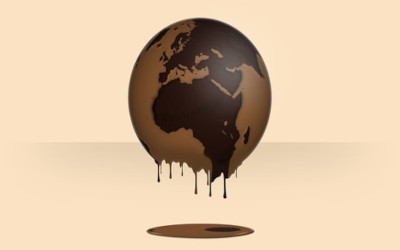Glaciers and ice caps cover only 10% of the Earth’s surface. The majority (99.5%) of the world’s permanent ice volume is found in ice sheets and glaciers. The Antarctic Ice Sheet holds the largest amount of frozen freshwater, and if it were to completely melt, it would cause a rise in sea levels of 57.9 meters. The Antarctic Ice Sheet covers 8.3% of the Earth’s land surface. The Greenland Ice Sheet has an ice volume that is equivalent to a rise in sea levels of 7.42 meters. It covers 1.2% of the total land surface on Earth. Ice is also found in the ground and permafrost regions, frozen lakes and rivers, and in seasonal snowfall. Sea ice and ice shelves are not considered to have any impact on raising the sea level because they are all already in the ocean.
Global warming has been causing a lot of ice melting around the Antarctic Peninsula. There have been a lot of collapsed ice shelves, and 87% of the glaciers are shrinking. Each year on the Antarctic Peninsula, the ice loss is over 41.5 gigatons. The Greenland ice sheet has been losing its mass for almost 20 years. It loses every year almost 247 gigatons from its volume, and by doing that, it gives the sea level an extra 0,69 mm. Greenland ice mass balance has been negative since 1995.
Ice on Earth acts as a cover. The bright white spots reflect sunlight back into the space, and by doing that, they keep the temperatures from rising. We need to protect the ice because it gives scientists knowledge about past climate changes. The melting of glaciers in Antarctica and Greenland is currently causing changes in the circulation of the Atlantic Ocean. This phenomenon has been connected to the decline of fisheries in the Gulf of Maine and the occurrence of more severe storms and hurricanes worldwide.
What would happen to North America if all the ice melted? The entire Atlantic coast, including Florida and the Gulf Coast, would disappear. In California, the hills of San Francisco would turn into a group of islands, and the Central Valley would become a huge bay. The Gulf of California would extend north beyond the latitude of San Diego, although San Diego itself would no longer exist.
What would happen to South America if all the ice melted? The Amazon Basin in the north and the Paraguay River Basin in the south could turn into inlets connected to the Atlantic Ocean, causing the destruction of Buenos Aires, coastal Uruguay, and most of Paraguay. However, mountainous areas along the Caribbean coast and in Central America would likely remain intact.
What would happen to Africa if all the ice melted? In comparison to other continents, Africa would experience less land loss if all the ice melted. However, the increasing global temperatures could render a significant portion of the continent uninhabitable. Specifically, cities like Alexandria and Cairo in Egypt would be overwhelmed by the encroaching Mediterranean Sea.
What would happen to Europe if all the ice melted? In Europe, the biggest cities would be gone, there would not be London, Venice, or Tallinn. Entire Netherlands would be long gone before even all the ice had melted, and most of Denmark would be gone too. As the Mediterranean expands, neither the Black Sea nor the Caspian Sea will exist in the future.
What would happen to Asia if all the ice melted? The area, which is currently occupied by 600 million Chinese people, would be underwater, along with all of Bangladesh, which has a population of 160 million, and a significant portion of coastal India. The flooding would also result in the isolation of Cambodia’s Cardamom Mountains, turning them into an island.
What would happen to Australia if all the ice melted? Australia would experience the formation of a new inland sea. However, this would result in the loss of a significant portion of the narrow coastal strip where four out of five Australians currently live.
In conclusion, if all the ice on Earth would melt, then the average temperature would be around 27 degrees Celsius, right now, the average temperature is 14 degrees Celsius. 27 degrees Celsius sounds really nice, but it would mean that billions of people and animals would lose their homes. If all the ice on Earth melts, it will raise the sea level by around 66 meters. Luckily, some scientists have said that it wouldn’t happen in the next 5000 years.

Sources:
https://www.antarcticglaciers.org/glaciers-and-climate/what-is-the-global-volume-of-land-ice-and-how-is-it-changing/
https://www.antarcticglaciers.org/glaciers-and-climate/climate-change/
https://www.nationalgeographic.co.uk/environment-and-conservation/2017/11/what-the-world-would-look-like-if-all-the-ice-melted
https://www.worldwildlife.org/pages/why-are-glaciers-and-sea-ice-melting
